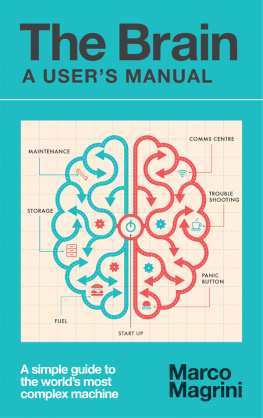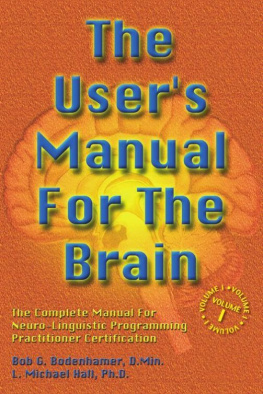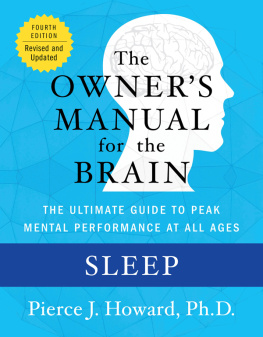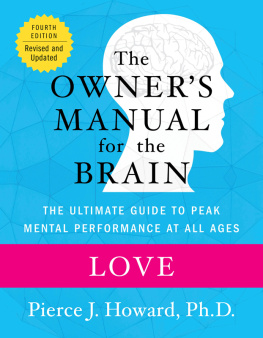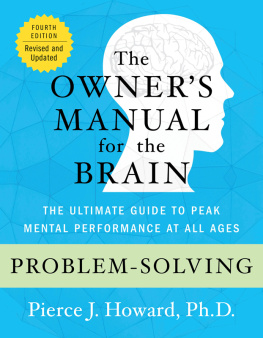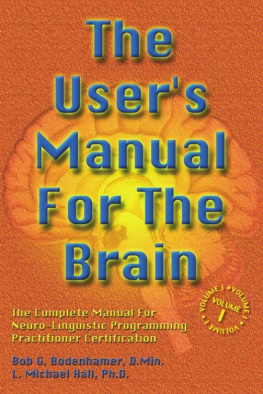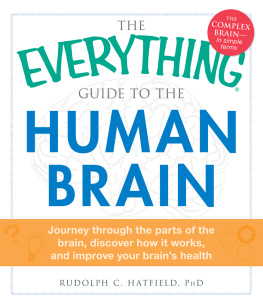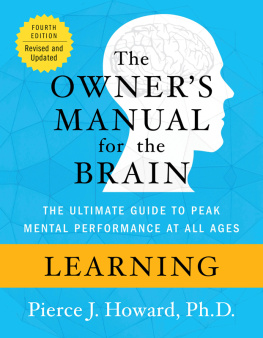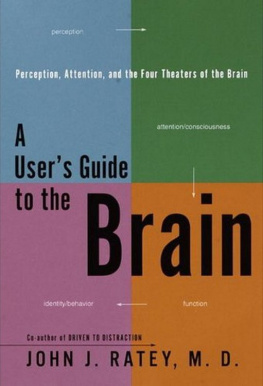
The content of this book is intended to inform, entertain and provoke your thinking. This is not intended as medical advice. Neither the author nor the publisher can be held responsible or liable for any loss or claim arising from the use, or misuse, of the content of this book.
To Jaja and Lilli
CONTENTS
GETTING STARTED
CONGRATULATIONS ON ACQUIRING THIS EXCLUSIVE PRODUCT, tailor-made for you. Please read this instruction manual carefully and keep it handy in case you need to refer to it later.
Your brain provides you with an extraordinary and unrivalled service. The availability of a sensory system for perceiving your environment and a nervous system that controls your motor apparatus, as well as an integrated consciousness that allows you to discern and decide, will sustain you for many years of existence.
As the famous inventor Thomas Edison said, The chief function of the body is to carry the brain around. Just another way of saying that we are our brains.
The world is littered with millions of manuals. There are over 700,000 on the manualsonline.com website, one for any appliance you might have: from a deep-fryer to a lawn-mower, an electric toothbrush to a garage door. And yet, in this microcosm of informational odds and ends, there is no mention of the most important device each of us possesses.
The brain is a machine, in the sense that it performs a complex series of computations at the same time as decrypting in real time information coming from the numerous connected peripheral senses, the most complex of which is our vision. The brains response can be likened to an algorithm, as though the mind were the software that runs on the hardware of the encephalon (the material within your skull).
The brain is not, of course, a machine in the literal sense. It is neither hardware nor software. Some call it wetware, the wetness element highlighting the biological nature of the brain machine.
It is the most wonderful and mysterious fruit of evolution.
Wonderful because there is nothing in the entire universe that matches its complexity. It is made up of the very elements of the periodic table that form the stars, patiently arranged in such a way as to produce thought, speech and action, not to mention history, philosophy, music and science.
Mysterious precisely because science an invention of the brain itself is aware of its woefully inadequate grasp on its inventor. In fact, it is aware that it knows next to nothing.
Not only do we not know exactly how the brain works but a consensus hasnt even been reached on what it actually is. The brains most amazing characteristic, consciousness (on which there is still no consensus, either), is a cerebral property that has sparked off centuries of furious debates and not just among theologians and philosophers. There is no unanimity among scientists, for example, on the frequent loss of consciousness we call sleep: there are over 20 different theories to date on why the brain needs to fall asleep (while still carrying on working). As a matter of fact, we dont even have a consensus on the nature of sleep disorders or some of their unpleasant consequences, such as depression. We could go on listing our ignorance ad infinitum. And yet there is a lot we do know.
The early philosophers wondered whether the mind resided in the brain or in the heart, and influential thinkers like Aristotle leaned towards the latter. Nowadays, we know that the brain is the control centre of the nervous system in all vertebrates and a large proportion of invertebrates. We know about the stages of the brains evolution. We know what its made of. We know the genetic code of every cell and we can interpret that code. We have new technologies, like fMRI (functional magnetic resonance imaging) and MEG (magnetoencephalography), which allow us to observe cognitive activities as they are happening. Were advancing at breakneck speed in our understanding of the entire system.
A fridge instruction manual is compiled by the fridge manufacturer. Yet when it comes to the brain, the result of millions of years of evolution, it is only by drawing together clues from generations of earlier brains that we will be able, in the end, to solve the mystery and compile a perfectly comprehensive instruction manual. This is intelligence trying to understand itself, almost as though this were the inevitable evolution of evolution.
An exhaustive manual of everything we know about the brain, or think we know, would be monumental, and accessible only to a neuroscientist. This particular manual, however, is for the average human brain user. Its a collection of basic instructions about the most complex thing there is, and so will we hope be ideal for practical, everyday brain usage.
There is a famous quote so famous, in fact, that its attributed to at least three different authors: If the human brain were so simple that we could understand it, we would be so simple that we couldnt.
Yet, in the end, of this were certain: humankind will succeed. Its only a matter of time. Not tomorrow but in 20, 100 or 200 years time, the brains of Homines sapientes will succeed in understanding themselves. But it will have taken a few hundred centuries of evolution for them to do so.
Technological progress, along with the extraordinary fruits of neuroscience over the last 20 years, confirms with every passing day the insight of Santiago Ramn y Cajal, one of the fathers of neuroscience back in the 1890s: Every man, if he so desires becomes the sculptor of his own brain.
Its right and good that your brain, like that of every other user, should know the whys and wherefores of this self-sculpting process.
1.0 OVERVIEW
EVERY SINGLE SECOND OF THE DAY, including this one, your central nervous system is a laboratory housing millions of chemical reactions of which youre unaware. They are the language used by the brain to receive, process and transmit information.
The brain has long been seen as a machine. Since every idea is a child of its time, Ren Descartes compared it to a hydraulic pump, Sigmund Freud to a steam engine, and Alan Turing to a computer. Turing came closest the brain isnt exactly a computer but theres an undeniable analogy between the two.
Both receive and transmit information by means of electrical messages. Its true that the messages are digital in the case of computers (expressed in the binary mathematics of zeros and ones) and analogue in the case of the brain (expressed in a variable arc of millivolts). But the brains messages can also be binary, yes or no, on or off: if the sum of analogue messages it receives goes beyond a certain level, a neuron fires and transmits an electrical impulse to connected neurons. If this level is not exceeded, nothing happens
Both compute. But where most computers have a serial structure, that is, they compute following a preordained sequence, the brain operates using a parallel method, performing a huge number of computations simultaneously .
.
Both have an expandable memory: in the case of the first you must add or replace silicon memory banks, while the second needs only to multiply synaptic connections through study, exercise and repetition .
Both have evolved over time: the computer at an exponential rate, doubling its processing power every two years, while the Homo sapiens
Next page
